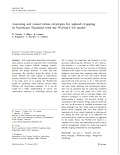| Journal Article |
 |
|
| Article Title | Assessing soil conservation strategies for upland cropping in Northeast Thailand with the WaNuLCAS model | | Author | W. Pansak, T Hilger, Betha Lusiana, T. Kongkaew, C. Marohn and G. Cadisch | | Year | 2010 | | Journal Title | Agroforestry Systems | | Institution | Springer Science+Business Media B.V | | Pages | 22 | | Call Number | JA0367-10 | | Keywords | Zea mays L. ; Runoff ; Soil loss ; Relay cropping ; Minimum tillage ; Hedgerows ; Modelling | | Notes | DOI 10.1007/s10457-010-9290-2 |
|
| Abstract: |
| Soil conservation approaches and agroforestry systems can play an important role in controlling erosion from tropical hillside cropping systems. Experimental testing of their potential application domain and design, however, is costly and time consuming. We, therefore, tested the ability of the Water, Nutrient and Light Capture in Agroforestry Systems (WaNuLCAS) model. The specific objectives of the study were: (i) to evaluate the WaNuLCAS model for predicting water induced erosion under different soil conservation strategies, (ii) to use the model for a better understanding of various soil
conservation measures in controlling erosion, and (iii) to assess the magnitude and dynamics of key processes influencing the efficiency of soil conservation measures. A 3-year-data set (2003–2005) from a field experiment from the Loei province in Northeast
Thailand on the impact of soil conservation (Leucaena hedgerow, Jack bean relay cropping) under minimum tillage on runoff and soil loss was tested. Results indicated thatWaNuLCAS was able to predict soil loss and runoff well at the test site; i.e. R2 = 0.80 and 0.82, respectively. In the calibration procedure a sub data set was used, where adjusting crop development parameters was an important step for improving simulated
soil loss (R2 = 0.75) and runoff (R2 = 0.89). Soilconservation measures such as Leucaena hedges were effective techniques to control runoff and soil loss. Implementing a dynamic soil structure module in combination with minimum tillage reduced runoff and soil loss via an increase in available macropores and hence drainage over time which improved simulation results. Relay cropping with Jack bean played an
important role in the control treatment in reducing soil loss during the third year due to its additional soil cover and positive impact on soil fertility as suggested by the model. Hence, the WaNuLCAS model is a valuable tool to study and understand processes and to explore management options for improving tropical hillside cropping threatened by soil degradation. |
|
|
Download file(s): Click icon to download/open file.
|
| |
File Size |
Description |

|
- |
URL |
|
|
GRP 2: Maximizing on-farm productivity of trees and agroforestry systems
GRP 6: Developing policies and incentives for multifunctional landscapes with trees that provide environmental services
|
| Viewed in 2376 times. Downloaded in 568 times. |